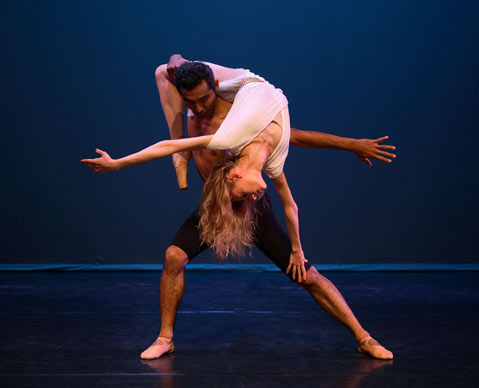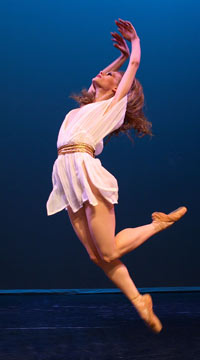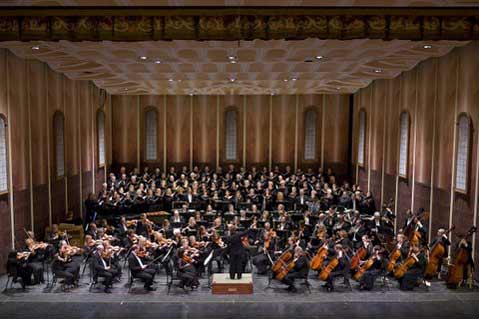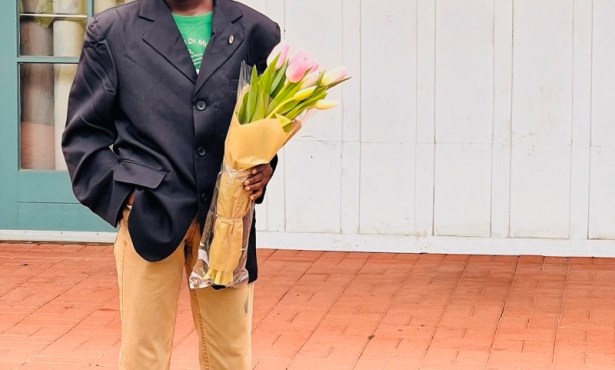State Street Ballet Unveils a New Carmina Burana at the Granada

The past five years have been exciting for Santa Barbara’s performing arts lovers. Our beloved Santa Barbara Bowl underwent a massive renovation to become a state-of-the-art mid-sized venue attracting top music acts, while between the Lobero Theatre and UCSB’s Arts and Lectures, we’ve enjoyed an explosion of performing arts programming. We’ve seen legendary performers like Mikhail Baryshnikov, Yo-Yo Ma, Bobby McFerrin, Morrissey, and Steven Sondheim on our stages. But it hasn’t been all about big-name artists and companies visiting town. We’ve also seen the emergence of a number of resident theater companies, the premiere of a biennial Shakespeare Festival, and the launch of a brand new ballet troupe. Homegrown organizations have been exploring new territory as well: Santa Barbara Dance Theatre toured China with works created right here at home, while Camerata Pacifica recently played in Britain and Ireland. Now, with State Street Ballet and the Santa Barbara Choral Society about to present a world premiere at the newly re-opened, 1,550-seat Granada Theatre, Santa Barbara seems destined to become even more world-class as a center for the performing arts.
Thinking Big
That’s exactly Rodney Gustafson’s intention.
Gustafson is artistic director of State Street Ballet (SSB), Santa Barbara’s 18-member, full-time professional dance company that has grown quietly and steadily over the past 15 years. In an era when many ballet companies across the nation are going deeper and deeper into debt or closing their doors, State Street Ballet has managed to stay afloat, even to soar. This weekend, in partnership with the Santa Barbara Choral Society (SBCS) and Orchestra, SSB unveils its latest production and its most dramatic project as of yet: an original, full scale, evening-length production of Carmina Burana at the Granada.

This is one of the largest original theater productions ever staged in Santa Barbara, and certainly the largest yet at the newly renovated theater. With 20 dancers, 100 singers, and 53 musicians, it’s unprecedented in scope and ambition, and it’s happening on a scale that would not have been possible in any other theater space in town. Not only does this Carmina Burana launch SSB and SBCS into a new realm of professionalism, it also points the way to one possible future of the performing arts in Santa Barbara-a future where collaborations between regional arts organizations will result in original, large-scale touring productions born right here on State Street.
It all started with Gustafson applying his artistic vision and business-minded pragmatism to the question, “How can we fill the Granada?” From the beginning, he saw that an artistic collaboration would result in a larger production and would draw upon a larger audience base. The next question was, “What production could bring many genres of art together?” To answer that question, Gustafson turned to his friend and colleague William Soleau, a New York-based choreographer who worked with SSB for years. Soleau had already created a number of original ballets for SSB, including Seasons, based on the poetry of Robert Frost, and a version of Georges Bizet’s Carmen, both of which were purely dance productions, but he had also choreographed A Midsummer Night’s Dream on Richmond Ballet for a production that incorporated a sung oratorio. “When you think about works that bring together voice, music, and dance,” Soleau said recently, “Carmina Burana is at the top of the list.”
Working from the Source
Soleau pointed out that although Carmina Burana is often performed either as a piece of choral music or as a ballet, its composer, Carl Orff, had always intended it to be a musical, choral, and dramatic production, or what he called a “Theatrum Mundi.” “He wrote in his notes that this was a scenic cantata-a combination of voice, music, and dance or mime,” Soleau explained. “He called it a theater-play.”
Orff, an early 20th-century music educator as much as a composer, based his composition on a collection of medieval poems discovered in Bavaria in the early 19th century. These poems, written primarily in secular Latin, are thought to be the works of scholars and clergy, but their tone is decidedly satirical, especially in reference to the church. Much of the content is bawdy, with double entendres and references to licentious activities and libidinous encounters. Orff’s work ties these writings to the theme of fate, beginning and ending the cantata with references to the fickle nature of destiny as represented by the Wheel of Fortune, and dividing the songs into three main sections: “Springtime,” “In the Tavern,” and “Court of Love.”
Many choreographers have staged Orff’s Carmina Burana since it was published in 1936, but most have avoided a literal interpretation. Because the music is so dramatic and so accessible-“O Fortuna” has been performed by countless ensembles and used in everything from credit card commercials to film soundtracks-ballet companies think of it as a crowd-pleaser; Cincinnati, Houston, Boston, and Pennsylvania ballets have all done versions of Carmina Burana in recent years. But Soleau sees his as different, and not only because of the collaborative aspect. “Some people do it in unitards, or underwear, or briefcases,” he said. “I’m pretty much doing it literally-the dancers will be dressed as if they’re from the 13th century. I’m also really paying attention to each of the poems.” Although Soleau acknowledges that some of Carmina Burana‘s content is too risque to portray literally, he is basing the choreography as closely as possible on the words. Luckily, the more explicit scenes-and Soleau’s choreographic departures from the script-won’t be obvious to many in the audience, unless you understand medieval secular Latin.
Taking on an original, large-scale production like this is certainly a risk, but Gustafson is confident the stars are aligned in his favor. “It’s taken us 15 years of evolution to get to the point of taking on such a major project,” he said. “We have the community’s trust, and their support.”

Brought Together by Fate
Their strongest support comes in the form of artistic partnership from the Santa Barbara Choral Society. Right from the start, Santa Barbara’s oldest performing arts organization was on board. When Brooks and Kate Firestone, relatively new members of SBCS, approached veteran music director JoAnne Wasserman with the idea, she was thrilled. SBCS had already performed Carmina Burana as a concert piece-those who attended the Granada’s gala opening heard them sing selections from the work-but Wasserman saw that the added dimension of ballet staging would take it to an entirely new level. Wasserman has chosen a number of guest soloists especially for the production and has assembled an orchestra of musicians who will accompany SBCS in two opening numbers, Aaron Copland’s Fanfare for the Common Man and Leonard Bernstein’s Chichester Psalms, before the ballet begins.
Speaking about the collaboration with SSB, Wasserman was elated. “It’s like we’re one company-we are not separate entities-and it’s exciting to have that connection with each other,” she said. “When that curtain goes up, we are one.”
Such a sense of solidarity between the organizations is especially impressive considering how little time they have had to rehearse in the same space. Because renting out the Granada for rehearsals is cost-prohibitive and fitting 100 singers (let alone 53 musicians and their instruments) into SSB’s ballet studios is a tight squeeze at best, the performers have had to make do with a single run-through all together before the in-house technical rehearsals immediately preceding the performance.
Soleau, who is creating the ballet, setting it on SSB’s dancers, and staging the production all within the span of three weeks, isn’t worried. “Because I’ve been around SSB for eight years, and I know the dancers well, I can come in and hit the ground running,” he explained.
Spinning the Wheel of Fortune
One of Soleau’s unique contributions is a narrative theme running through the production in which the events of each section are seen through the eyes of an older couple reflecting on their youth. “They are looking back and seeing how fate manipulated their lives all along,” Soleau explained. “This older couple is completely my creation. I wanted to give the audience a beginning, middle, and end, so that they could identify more with the story.”
Because the Granada’s stage is not wide enough for the singers to be placed at the sides, they will stand on upstage risers behind the dancers. Soleau has never choreographed a ballet this way, but says he welcomes the challenge. “These dancers are great,” he said. “They know me; they’re flexible, versatile, fast, and eager to learn. Rodney has been instrumental in mentoring me and giving me fortitude to take on a project of this scale that I might not have taken on before.”
Gustafson also sees this production as a milestone for SSB-especially as the company makes the transition from the Lobero to the Granada, and from its State Street studios to a new, larger space at the 101 and Las Positas. The hope is that although Santa Barbara will be the first city to enjoy this production, it won’t be the last-Gustafson plans to promote Carmina Burana as a touring show once it’s had its debut. Whether or not the show will garner enough interest remains to be seen-much rests on this weekend. “We’re taking a risk,” Gustafson acknowledged. “For Santa Barbara, this is a really big event.”
Wasserman agrees that this Carmina Burana is a groundbreaking production, both for SBCS and for Santa Barbara. “This ballet is a world premiere performance,” she pointed out. “That’s the one thing that’s most exciting: It has never been seen before.”
4•1•1
State Street Ballet and the Santa Barbara Choral Society and Orchestra present Carmina Burana at the Granada Theatre on Saturday, May 31, at 8 p.m., and on Sunday, June 1, at 2 p.m. For tickets or more information, call 899-2222 or visit granadasb.org.



